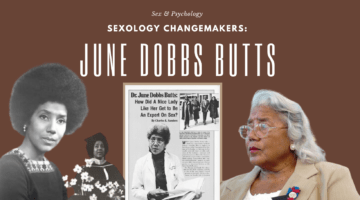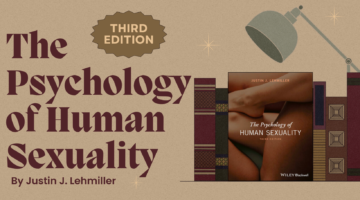Pornography is Dangerous for Teens? Chill Out, The Kids are Going to be (Mostly) Alright
December 13, 2019 by Justin Lehmiller
Americans have become increasingly fond of calling pornography a “public health crisis.” Those who claim this frequently cite adolescents’ “rampant access to pornography” as a central concern. Parents are encouraged to panic because “[p]orn is radically undermining the healthy development of children and youth, and contributing to increasing levels of sexual inequality, dysfunction, and violence.” Of critical importance to this view is that the internet has allowed children to access pornography at increasingly younger ages and youth are especially vulnerable to its harmful effects.
Is all of this panic justified, though? Is pornography really as dangerous as some claim?
In early 2018, I was invited to join a group of hard-working sociologists in the Republic of Croatia to help them examine and publish data they had been collecting about adolescents’ pornography use. This was my first serious foray into the academic literature concerning teen porn use, but I tackled the work with gusto. I’ve since been reading and publishing as much as I can about this topic in academic channels; however, I’ve said very little about it in more public forums, where my take on this issue will likely be unsettling to many people because it conflicts with the popular narrative about the damaging effects of porn. When it comes to pornography, I genuinely think that the kids are going to be (mostly) alright.
If you look beyond the rhetoric and take the time to read the actual research, it is very difficult to conclude that adolescents are in a state of crisis because of pornography. Whether we’re talking about pornography’s influence on sexual health, mental / psychological well-being, or rape-supportive attitudes and behaviors, there’s really not a whole lot going on. Sure, there’s tons of research one could cite to make the case that pornography is destroying adolescents, but much this work relies on overly simplified theoretical ideas and poor research practices designed to confirm morally-inspired presumptions about the harms of such materials. Critical analysis and reflection is often absent from this literature and inconsistent findings are typically ignored.
It turns out that the effects of pornography, to the extent that they actually exist at all, are very subtle. So subtle in fact, that when it comes to real-world issues of societal import, like safer-sex, the effects are not consistently detected across studies. A quick review of the literature, for example, indicates that three studies find that pornography-using teens report less consistent condom use than teens who don’t use porn (Luder et al., 2011; Wingood et al., 2001; Wright, Tokunaga, & Kraus, 2016). Further reading, however, indicates that another three studies find no association between pornography consumption and condom use (Braun-Courville & Rojas, 2009; Lim, Agius, Carrotte, Vella, & Hellard, 2017; Sinković et al., 2013). Moreover, recent Croatian research that I was involved in found no evidence that pornography use was associated with decreases in subsequent condom use in two groups of adolescents who were followed over time (Koletić, Štulhofer, & Kohut, 2019).
When it comes to risky sex beyond condom use, the story is essentially the same. Whether we’re talking about condom use, age of first intercourse, or number of sexual partners, we really do not have firm evidence that pornography is clearly or strongly influencing sexual risk behaviors.
Given the modest—at best—and conflicting findings, it shouldn’t be surprising that post-internet adolescents are actually doing better on many markers of sexual risk taking than pre-internet teens. Condom use and age of first intercourse have both increased, while rates of unintended pregnancies and abortions have decreased among teens in the age of unrestricted access to explicit models of risky sexual behaviors. If there are negative impacts on pornography on the sexual health of adolescents, they are clearly not strong enough to counteract these societal trends.
With respect to sexual health (and many other presumed “harms”), porn has become a boogeyman. If you are legitimately worried about the sexual health of teens (and you should be, given the notably high level of STIs in this population), pointing the finger at porn is really a distraction from bigger issues. Research tells us that factors like recreational substance use, “abstinence only” sexual education, over-reliance on hormonal methods of birth control (which only protect against unintended pregnancy and not STIs), and the general lack of parental communication about safer sex, should all be much more concerning to you than teens’ access to online porn.
Now, I often get the impression that people think of me as a porn apologist. I like to think that I’m not, or at least that I try not to be. In this spirit, I am going to suggest an important caveat about my conclusions. Scholars like me, that is, those in fields like psychology, communication science, or sociology, rely heavily on research practices that can only speak to what pornography might be doing “on average,” and can’t really speak to what porn might be doing for any given individual, in any given circumstance.
With this point in mind, while I feel quite comfortable concluding that pornography is relatively harmless for teens “on average,” that doesn’t mean that pornography can’t have harmful impacts for specific people in specific circumstances. Just who those people and what those circumstances are, however, remain largely unanswered questions.
One important circumstance might be the typical lack of comprehensive sexuality education. A point on which we can probably all agree is that pornography should not be the sole or primary source of information about sexuality for kids. Porn is a fictionalized drama, and while many adolescents recognize this, some do not. In a social context of poor sexual education, both within the home and within schools, teens—and adults—who strongly believe that pornography offers an idealized template for sexual interactions are in for a world of problems.
Let me leave you with a metaphor that I use in my human sexuality classes: Imagine if we lived in a world where Driver’s Education was more like your typical Sex Education class, replete with incomprehensible diagrams of the combustion engine and full of curious details like “pistons,” “crank-shafts,” and “exhaust manifolds.” Such complicated and incomprehensible instruction would almost always be accompanied by exposure to explicit visual reminders of the personal and social harms of unsafe driving.
If you were a “lucky” student, a public health nurse might teach you how to properly apply your seatbelt across an oversized stuffed banana that roughly approximates the size and shape of the human body. Most importantly, at no time would you be allowed to look at, handle, or get into a car before you reach a magical and arbitrary age. Even then, you would only be allowed to do so once you’ve made a life-long commitment to a single car, and it would be expected that you would only use it for its intended purpose: to get you off somewhere.
If this was the world in which we lived, illicit movies like Fast and Furious 8—which glorify the glistening curves of the automobile, the ecstatic cries of their engines, and the outright exhilaration of reckless and promiscuous (if a little unrealistic) driving—would give many of us cause for concern. In such a scenario, which of the following do you think best serves the public good: preventing teenagers from seeing a movie intended for adults or giving them frank, comprehensive, and effective Driver’s Education?
Thanks to Dr. Taylor Kohut for this guest post! Follow Taylor’s work here.
Want to learn more about Sex and Psychology? Click here for previous articles or follow the blog on Facebook (facebook.com/psychologyofsex), Twitter (@JustinLehmiller), or Reddit (reddit.com/r/psychologyofsex) to receive updates. You can also follow Dr. Lehmiller on YouTube and Instagram.
Image Credits: 123RF/Stas Vulkanov
Check out these other interviews with authors:

Dr. Justin Lehmiller
Founder & Owner of Sex and PsychologyDr. Justin Lehmiller is a social psychologist and Research Fellow at The Kinsey Institute. He runs the Sex and Psychology blog and podcast and is author of the popular book Tell Me What You Want. Dr. Lehmiller is an award-winning educator, and a prolific researcher who has published more than 50 academic works.
Read full bio >


